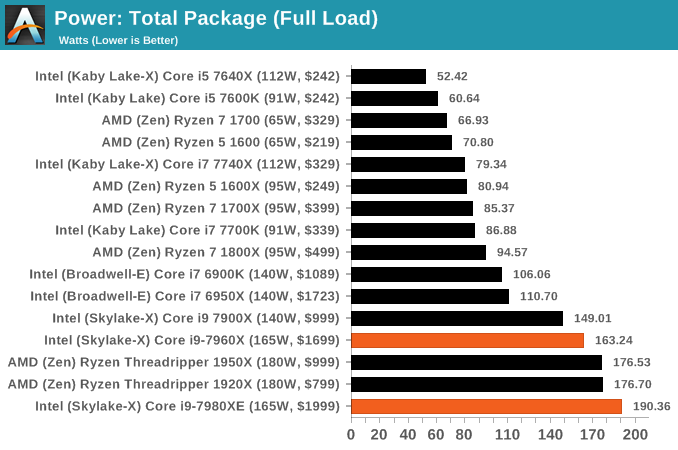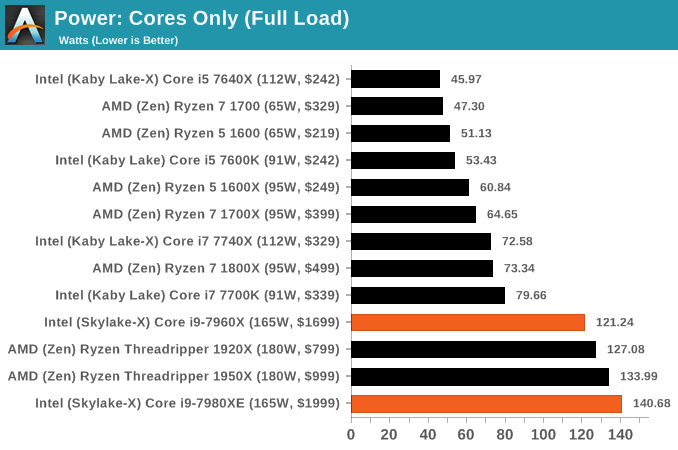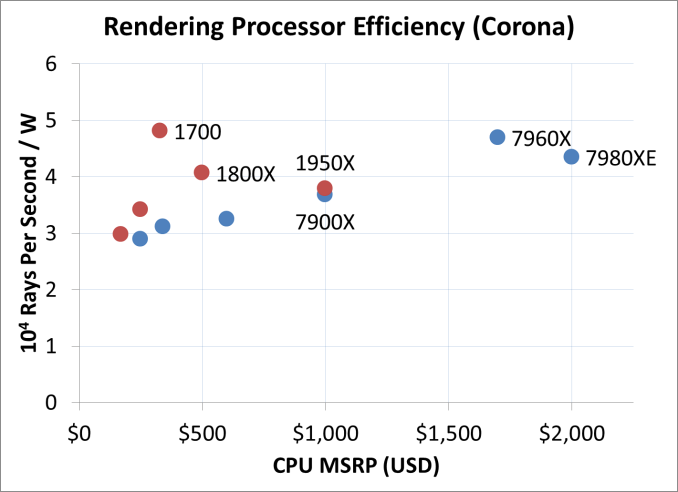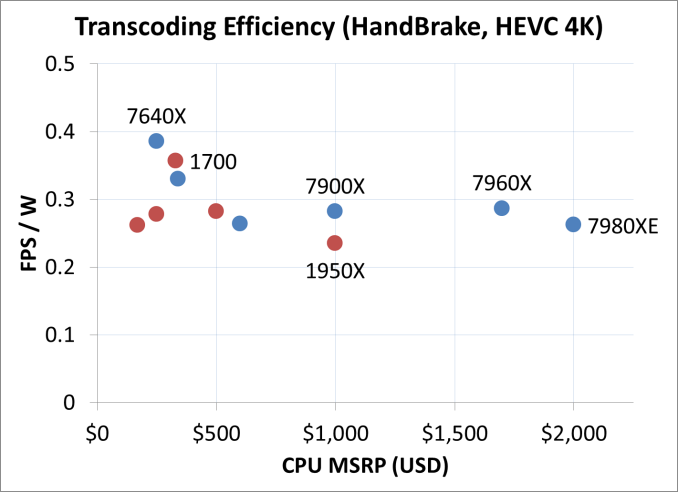The Intel Core i9-7980XE and Core i9-7960X CPU Review Part 1: Workstation
by Ian Cutress on September 25, 2017 3:01 AM ESTA Few Words on Power Consumption
When we tested the first wave of Skylake-X processors, one of the take away points was that Intel was starting to push the blurred line between thermal design power (TDP) and power consumption. Technically the TDP is a value, in Watts, to which a CPU cooler should be designed to cope with heat energy of that amount: a processor with a 140W TDP should be paired with a CPU cooler that can dissipate a minimum of 140W in order to avoid temperature spikes and ‘thermal runaway’. Failure to do so will cause the processor to hit thermal limits and reduce performance to compensate. Normally the TDP is, on average, also a good metric for power consumption values. A processor with a TDP of 140W should, in general, consume 140W of power (plus some efficiency losses).
In the past, particularly with mainstream processors, and even with the latest batch of mainstream processors, Intel typically rides the power consumption well under the rated TDP value. The Core i5-7600K for example has a TDP of 95W, and we measured a power consumption of ~61W, of which ~53W was from the CPU cores. So when we say that in the past Intel has been conservative with the TDP value, this is typically the sort of metric we will quote.
With the initial Skylake-X launch, things were a little different. Due to the high all-core frequencies, the new mesh topology, the advent of AVX-512, and the sheer number of cores in play, the power consumption was matching the TDP and even exceeding it in some cases. The Core i9-7900X is rated at 140W TDP, however we measured 149W, a 6.4% difference. The previous generation 10-core, the Core i7-6950X was also rated at 140W, but only draws 111W at load. Intel’s power strategy has changed with Skylake-X, particularly as we ramp up the number of cores.
Even though we didn’t perform the testing ourselves, our colleagues over at Tom’s Hardware, Paul Alcorn and Igor Wallossek, did extensive power testing on the Skylake-X processors. Along with showing that the power delivery system of the new motherboards works best with substantial heatsinks and active cooling (such as a VRM fan), they showed that with the right overclock, a user can draw over 330W without too much fuss.
So for the two processors in the review today, the same high values ring true. Almost to the point of it being alarmingly so. Both the Core i9-7980XE and the Core i9-7960X have a TDP rating of 165W, and we start with the peak headline numbers first. Our power testing implements a Prime95 stress test, with the data taken from the internal power management registers that the hardware uses to manage power delivery and frequency response. This method is not as accurate as a physical measurement, but is more universal, it removes the need to tool up every single product, and the hardware itself uses these values to make decisions about the performance response.

At full load, the total package power consumption for the Core i9-7960X is almost on the money, drawing 163W.
However the Core i9-7980XE goes above and beyond (and not necessarily in a good way). At full load, running an all-core frequency of 3.4 GHz, we recorded a total package power consumption of 190.36W. This is a 25W increase over the TDP value, or a 15.4% gain. Assuming our singular CPU is ‘representative’, I’d hazard a guess and say that the TDP value of this processor should be nearer 190W, or 205W to be on the safe side. Unfortunately, when Intel started designing the Basin Falls platform, it only was designed to be rated at 165W. This is a case of Intel pushing the margins, perhaps a little too far for some. It will be interesting to get the Xeon-W processors in for equivalent testing.
Our power testing program can also pull out a breakdown of the power consumption, depending if the registers are preconfigured in the software. In this case we were also able to pull out values for the DRAM controller(s) power consumption, although looking at the values this is likely to include the uncore/mesh as well. For both CPUs at load, we see that this DRAM and mesh combination is drawing ~42W. If we remove this from the load power numbers, that leaves 121W for the 16-core chip (7.5W per core) and 140W for the 18-core chip (7.8W per core).

Most of the rise of the power consumption, for both the cores and DRAM, happens when the processor is loaded to four threads - the Core i9-7980XE is drawing 100W+ when four threads are loaded. This is what we expect to see: when the processor is lightly loaded and in turbo mode, a core can consume upwards of 20W, while at load it will migrate down to a smaller value. We saw the same with with Ryzen, drawing 17W per core when lightly threaded down to 6W per core when loaded. Obviously the peak efficiency point for these cores is down nearer the 6-8W range than up at the 15-20W range.
Unfortunately, due to timing, we did not perform any overclocking to see the effect it has on power. There was one number in the review materials we received that will likely be checked with our other Purch colleagues: one motherboard vendor quoted the power consumption of the Core i9-7980XE, when overclocked to 4.4 GHz, will reach over 500W. I think someone wants IBM’s record. It also means that the choice of CPU cooler is an important factor in all of this: very few off-the-shelf solutions will happily deal with 300W properly, let alone 500W. These processors are unlikely to bring about a boom in custom liquid cooling loops, however for the professionals that want all the cores and also peak single thread performance, start looking at pre-built overclocked systems that emphasize a massive amount of cooling capability.
A Quick Run on Efficiency
Some of our readers have requested a look into some efficiency numbers. We’re still in the process of producing a good way to represent this data, and take power numbers directly during the benchmark to get a full accurate reading. In the meantime, we’re going to take a benchmark we know hammers every thread of every CPU and put that against our load power readings.
First up is Corona. We take the benchmark result and divide by the load power, to get the efficiency value. This value is then reduced by a constant factor to provide a single digit number.
In a rendering task like Corona, where all the threads are hammered all the time, both the Skylake-X parts out-perform Threadripper for power efficiency, although not by twice as much. Interestingly the results show that as we reduce the clocks on TR, the 1700 comes out on top for pure efficiency in this test.
HandBrake’s HEVC efficiency with large frames actually peaks with the Core i5 here, with the 1700 not far behind. All the Skylake-X processors out-perform Threadripper on efficiency.












152 Comments
View All Comments
extide - Monday, September 25, 2017 - link
No, TDP should include Turbo as that is part of the base/stock operation mode of the CPU.IGTrading - Monday, September 25, 2017 - link
TDP = Total Design Power by definition.This is used to design the motherboard and the cooling system to give designers a clear limit over which the system doesn't go unless it is purposely overcloked.
Wikipedia : "The thermal design power (TDP), sometimes called thermal design point, is the maximum amount of heat generated by a computer chip or component (often the CPU or GPU) that the cooling system in a computer is designed to dissipate under any workload."
Intel : "TDP (Thermal Design Power) Intel defines TDP as follows: The upper point of the thermal profile consists of the Thermal Design
Power (TDP) and the associated Tcase value. Thermal Design Power (TDP) should be used for
processor thermal solution design targets. TDP is not the maximum power that the processor can
dissipate. TDP is measured at maximum TCASE.1"
Intel : "Due to normal manufacturing variations, the exact thermal characteristics of each individual processor are unique. Within the specified parameters of the part, some processors may operate at a slightly higher or lower voltage, some may dissipate slightly higher or lower power and some may draw slightly higher or lower current. As such, no two parts have identical power and thermal characteristics.
However the TDP specifications represent a “will not exceed” value. "
This is what we've understood by TDP in the past 21 years while in IT hardware industry.
If you have a different definition, then perhaps we're talking about different things.
whatevs - Monday, September 25, 2017 - link
Specification for 7980xe says "Thermal Design Power (TDP) represents the average power, in watts, the processor dissipates when operating at Base Frequency with all cores active under an Intel-defined, high-complexity workload. Refer to Datasheet for thermal solution requirements."There's a different specification for electrical design. This is not your ancient Xeon TDP.
IGTrading - Monday, September 25, 2017 - link
You mean the definition of TDP should change every year to suit Intel's marketing ?! :)"Ancient" Xeon TDP ?! :)
I've quoted Intel's own definition.
If the company just came up with a NEW and DIFFERENT definition just for the Core i9 series, then that's just plain deceiving marketing, changing with the wind (read : new generation of products) .
Plus, why the heck are they calling it TDP ?!
If they now claim that TDP "represents the average power, in watts, the processor dissipates when operating at Base Frequency with all cores active " then they basically use AMD's ACP from 2011.
What a load of nonsense from Intel ...
https://www.intel.com/content/dam/doc/white-paper/...
whatevs - Monday, September 25, 2017 - link
You have quoted 6 year old Xeon definition, different products have different operating conditions, deal with it.Spunjji - Monday, September 25, 2017 - link
Your name suggests that you're kind of a dick and your comments confirm it. Your point is weak and doesn't at all do the work you think it does.whatevs - Monday, September 25, 2017 - link
You may be unhappy with what Intel promised you, but to claim that you could burn a system with increased power usage from turbo clocks is ridiculous, thermal throttling is not fire, and it's ridiculous to argue on a cpu that can run overclocked at >400w power consumption.Notmyusualid - Monday, September 25, 2017 - link
+1wolfemane - Tuesday, September 26, 2017 - link
You can't talk rationale with a loyalist sympathizer. TDP is a set definition in the industry and one Intel seems to be misleading about with their Extreme HEDT CPU. That seems to be a fact clearly made among almost all reviews of the 7980xe.I think I read a few articles yesterday talking about how the 7980xe was having major issues and wasn't boosting correctly but showing high power draw. But yesterday was a long time ago and I cant remember where I read that.
someonesomewherelse - Saturday, October 14, 2017 - link
So why not call it 'Average Design Power - ADP'?